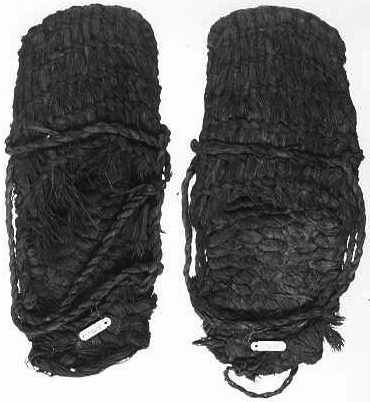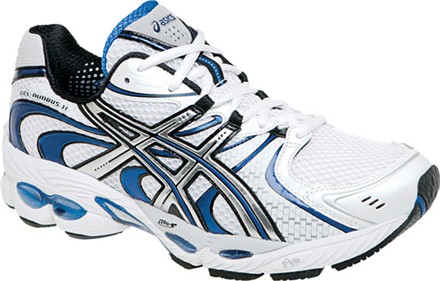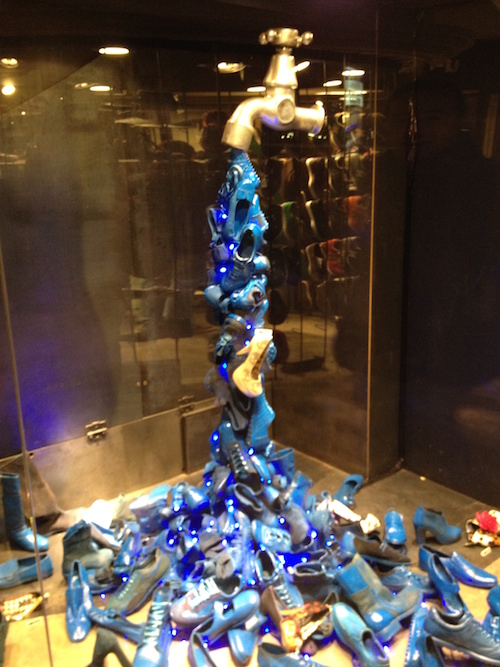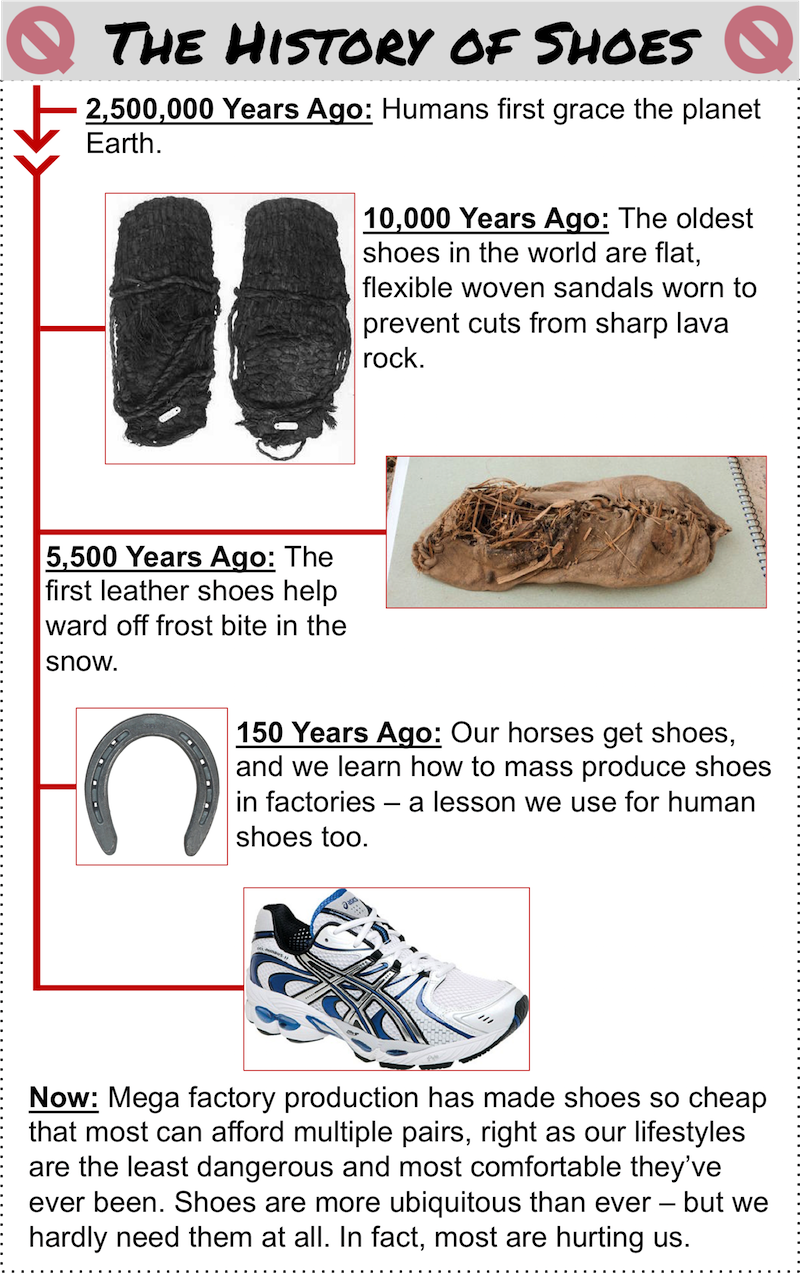If you’re reading this, you probably have internet access (or a very generous friend with a printer). And if you have internet access, you’ve likely worn shoes the majority of your life, at least outdoors. In the modern first world, shoes are so ubiquitous that the ability to tie one’s own pair is a marker of child development.
Ok, we get it. Everyone wears shoes.
But it wasn’t always that way. In fact, for the majority of human existence, shoes weren’t a thing at all. Let’s take a look at the history of shoes – and what it means for us today.
The First Human Shoes – Extra Skin
The oldest known human shoes appear to have been use in 8,000 BC. They were sandals made of woven twine, flat and flexible. The intention of these “Fort Rock Sandals” was not support or comfort, it was protection for the soles of the feet.

The first human shoes, in use 8,000 years BC, were flat and flexible sandals designed for protection from sharp volcanic rock. [img credit]
Note: 8,000 BC sounds like a long time ago to most of us. But that’s only 10,000 years ago, roughly 0.4% of our time on this planet.
The first pair of leather shoes, dated back to 3,500 BC, were very similar in design. Flat and flexible, this time designed to increase comfort as our species expanded further into snowy territory.

Leather shoes were first worn 4,500 years later, for protection from the biting cold of snow. [img credit]
Domesticating Animals Changed Shoes Forever
Horseshoes were developed around the beginning of the modern era, and they harkened a change to footwear forever for humans too. Wikipedia has an excellent article on the subject, we’ll grab a few pertinent excerpts:
Many changes brought about by domestication of the horse have led to a need for shoes for number of reasons, mostly linked to management that results in horses’ hooves hardening less and being more vulnerable to injury… Working animals were found to be exposed to many conditions [on the farm] that created breakage or excessive hoof wear.
Horse hooves weren’t designed for farm work. When we started putting an unnatural burden on them, we had to outfit them with unnatural equipment.
The earliest clear written record of iron horseshoes is a reference to “crescent figured irons and their nails” in AD 910. Around 1000 AD, cast bronze horseshoes with nail holes became common in Europe. Common was a design with a scalloped outer rim and six nail holes.
So a little over 1000 years ago, we arrived at the design we all know as the Horseshoe. Pretty recent, because real horses living real horse lives do not need shoes:
In the wild… horses’ feet are naturally worn to a small, smooth, even and hard state. The continual stimulation of the sole of the foot keeps it thick and hard.
However, in domestication, the ways horses are used differs from their natural environment. Domesticated horses were brought to colder and wetter areas than their ancestral habitat. These softer and heavier soils soften the hooves and have made them prone to splitting, making hoof protection necessary.
I’m noticing a trend here. Humans only needed shoes when they tried to live on the sides of volcanoes or in the snow. Horses only needed shoes because they too were brought to an unnatural environment.
Shoes started as a tool for protection in unfriendly, unnatural conditions.
Horseshoes taught us more than how to get work from animals in suboptimal environments. It also taught us how to mass produce shoes.
Shoes Go Factory – Become Commonplace
Once you have a factory making horseshoes, why not start making human shoes too? That’s exactly what we did:
Shoemaking became more commercialized in the mid-18th century.. by the [19th] century’s end, the process had been almost completely mechanized, with production occurring in large factories… [and] obvious economic gains of mass-production.
Now, shoes were available in stores! For the first time, you didn’t need to make your own or pay exorbitant rates to a craftsmen to get a pair. Naturally, this lowered the threshold for acquisition. If you need to spend a ton of time or money, you won’t get shoes unless you really need them. But when they’re cheap and easy to grab, suddenly shoes become ubiquitous.
The Modern Era – Heels, Padding, Support
Shoes started for protection. But as they became increasingly cheaper – and our lives increasingly more comfortable – we can prioritize fashion and comfort. And since most of us stopped spending appreciable time in environments any harsher than a cubicle, the primary value add of shoes had to change as well.

HILARIOUSLY different from the first shoes we saw earlier.
Footwear couldn’t be about protection anymore because most consumers didn’t need protection. Marketing messages focused instead on increasing comfort, and improving on a system that didn’t need any improvement.
An ad for shoes in 8000 BC might have read: “Feet keep getting cut on lava rock? Try shoes.”
Fast forward to 1990 AD, and the message became: “Want to be thin and sexy? Our shoes feature incredible support and advanced cushioning technology. That means you can run further and burn more calories than ever before. Just do it!”
No one noticed that if you need crazy technology to blunt the pain of running miles on end – something else needs to change. Maybe your form is terrible. Maybe you just shouldn’t be running unnaturally far for vanity.
Wrapping Up – Rethink Your Shoes
As we’ve seen, humans have been barefoot for over 99% of our time on this planet. You can do it too! Especially given that you likely spend the overwhelming majority of your existence on flat hardwood, carpet, or concrete.
Of course, wearing supportive restrictive shoes your entire life has likely atrophied your muscles and made your feet soft. So start smart and slow. Try some barefoot shoes (for men or women), and ease back not natural movement gradually.
You’ll be amazed by the physical and mental benefits. And you’ll be honoring your ancestors and design.
Have you tried barefoot or minimal shoes? Let us know in the comments!







Barefoot is better. In fact, is the best !
Getting out of my padded, motion-controlled shoes changed my life. My running-related injuries went away, I developed arches in my previously life-long flat feet… and because I wanted to be as close to barefoot as I could as often as I could (in places and situations that were not conducive to actual bare feet), I started http://www.XeroShoes.com... and have had the pleasure of introducing tens of thousands of people to barefoot and true minimalism.
BTW, GREAT site, guys! I’m writing this comment while walking at my treadmill desk 😉
Thanks Steven!
I try to go barefoot as much as possible. Probably why I wear a “wide” shoe. I ran barefooted most of my childhood. I once went to school barefooted (second grade) because I couldn’t find my shoes. I was sent back home (they sent me walking home barefooted ironically) to get my shoes. I did find them, but I wondered why if it were so bad to be barefooted at school, why did the teacher send me home still barefooted instead of protecting me (as if I needed it) and drive me home? Anyway, at 56, I still go barefooted as much as possible.
I had problems with plantar fasciitis. I started wearing shoes that are as near barefoot as I can and haven’t had another flare up.